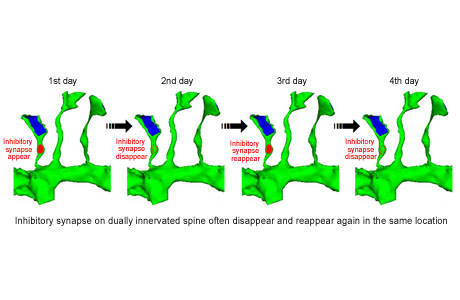Inhibitory synapses are repeatedly assembled and removed at persistent sites in vivo.
Older concepts of a hard-wired adult brain have been overturned in recent years by in vivo imaging studies revealing synaptic remodeling, now thought to mediate rearrangements in microcircuit connectivity. Using three-color labeling and spectrally resolved two-photon microscopy, we monitor in parallel the daily structural dynamics (assembly or removal) of excitatory and inhibitory postsynaptic sites on the same neurons in mouse visual cortex in vivo. We find that dynamic inhibitory synapses often disappear and reappear again in the same location. The starkest contrast between excitatory and inhibitory synapse dynamics is on dually innervated spines, where inhibitory synapses frequently recur while excitatory synapses are stable. Monocular deprivation, a model of sensory input-dependent plasticity, shortens inhibitory synapse lifetimes and lengthens intervals to recurrence, resulting in a new dynamic state with reduced inhibitory synaptic presence. Reversible structural dynamics indicate a fundamentally new role for inhibitory synaptic remodeling—flexible, input-specific modulation of stable excitatory connections.

Collaborative Researcher
Names:Villa KL, Berry KP, Subramanian J, Nedivi, E
Department:Massachusetts Institute of Technology, Cambridge, MA 02139, USA
Institute:Picower Institute for Learning and Memory
Names: Cha JW, So PT
Department:Department of Mechanical Engineering
Institute: Massachusetts Institute of Technology
Names: Oh CO, Kwon H-B
Institute:Max Planck Florida Institute for Neuroscience
Funding
grant-in-aid for scientific research from the Ministry of Education, Culture, Sports, Science and Technology of Japan (B) 25290012;
on Innovative Areas-Adaptive circuit shift (Number 3603); 26112006 and 15H01456 the Imaging Science Project of CNSI, National Institutes of Natural Sciences (NINS) IS261004

